The main ways to improve the efficiency of the hydromechanized complex are: reducing its material consumption and energy consumption, increasing abrasion and corrosion resistance, reducing operating costs.
Authors:

Chizhov A.E.
Director of LLC "Rassvet"

Chizhov A.E.
Ph.D., professor
Deputy. Director of LLC "Rassvet"
The main ways to improve the efficiency of the hydromechanized complex are: reducing its material consumption and energy consumption, increasing abrasion and corrosion resistance, reducing operating costs.
The use of polymer composite materials allows us to solve some of these problems. When choosing polymeric materials, it must be borne in mind that they must comply with a number of technical, economic and operational requirements:
- minimum weight and cost;
- high hydraulic characteristics;
- resistance to cyclic and shock loads;
- high maintainability;
- atmospheric, light and water resistance;
- tensile strength, providing a reliable transfer of traction from the dredger to the end pontoon;
- resistance to abrasion and abrasion.
Flexible flexible conduit
Flexible elastic pipeline manufactured by "Dawn-K" consists of power elements (fabric, metal cord), sealing inner coating (wear-resistant rubber) and an outer protective layer, resistant to hydroabrasive wear. Flexible pipelines are manufactured with a diameter of 150 to 900 mm, a length of 7.3 m, and a working pressure of up to 4 MPa. Pipelines can be manufactured in a floating version. On average, the life of our pipelines for hydroabrasive wear is 5-8 times greater than that of steel pipes, they have increased resistance to aggressive media.
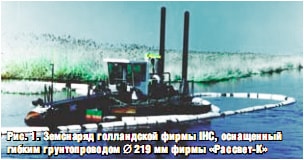
Pressure floating elastic pipelines with flanges are used in hydromechanization as ground lines. With bending radii of 10-12 of its diameters, it retains its shape and, thus, does not require ball joints and gaskets (pic. 1).
The absence of ball joints, the elasticity of our pipelines makes it possible to move slurries of increased concentration (up to 50% on a solid basis). The buoyancy of the underground pipeline is provided by floats, which are made of a material resistant to mechanical action - foam polyethylene. Apparent density of float material is in the range of 60-110 kg / m3. Water absorption is not 1.2%; Deformation under the influence of external loads up to 0.03 mPa does not exceed 10%.
As a rule, we hang 7-9 floats on one pressure pipe. The buoyancy of the pipeline is calculated in such a way that when it is completely blocked, it is not less than 5-10%. Fastening of floats is carried out by low-stretch polyester or steel belts. The outer covering of the floats is reinforced with a welded metal mesh or has a protective fabric cover (pic. 2).
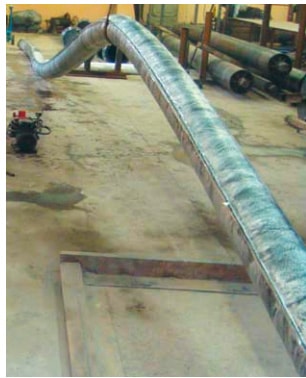
The table shows the main dimensions of the floats, depending on the diameter of the earthwork.
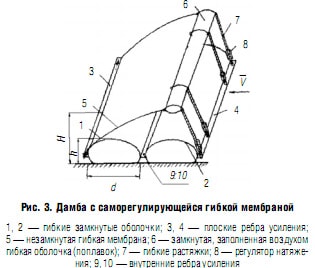
It can be seen from the table that as the diameter of the pressure pipes increases, the diameter of the floats also increases, starting with a diameter of 530 mm, the transport efficiency is somewhat reduced. For example: 150 m of floating elastic pipes with a diameter of 325 mm with a length of 7.3 m with foamed polyethylene floats can be transported by one machine, and floating elastic pipes with a diameter of 530 mm with floats 900 mm in diameter - only 8-9 pieces (pic. 3).
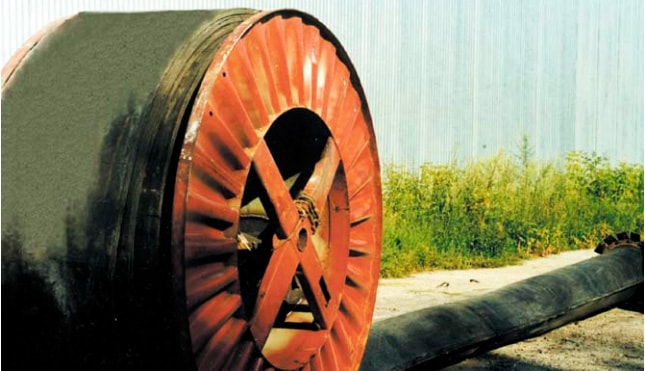
The buoyancy of the pipeline can also be provided by pneumatic floats. In pic. 4 presents different variants of the arrangements of pneumatic floats.
Floating soil pipeline, manufactured by the company "Rassvet-K" under the scheme "b" with a vertical arrangement of floats, is protected by the Russian Patent No. 2007131035/03 and is intended for operation in the marine environment of the North, in the Baydarak Bay of the Kara Sea. In this region, a complex ice situation, and, in our opinion, the most rational is the penetration of the ground pipeline with respect to a free surface. Having a flexible connection with the ground pipe, when piled on it with ice floes, the float works like "Vanka-Vstanka": by passing the floating ice floe, it rises into place.
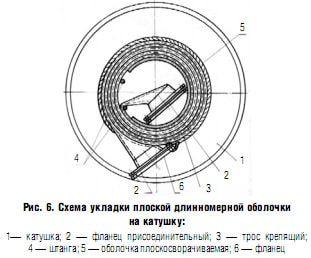
Combined floats are promising. Floating pipes with combined floats have a minimum foam polyethylene coating, ensuring the buoyancy of "empty" pipes, and pneumatic floats that are manufactured in flat form and are transported to the inner cavity of the pipe during transportation.
A comparative analysis of flexible groundwater production company "Rassvet-K" shows:
At a cost, flexible soil pipes are four times cheaper than steel reflowers. For example, the link floating T80.000.000A with a length of 7 m DN 300 mm made of steel costs about 200,000 rubles, and the link of the floating pipeline DNPP DN 325 mm of the same length costs 53,000 rubles.
For transportation of one section of steel refueller with pontoons, one machine is required, a flexible re-finer of 20 sections DN 325 mm with a length of 150 p / m is also transported by one machine.
Time for installation and dismantling of a flexible floating pipeline is much less, than the steel one with pontoons and balls (the weight of one section of a steel refiner Du 300 mm is 2500 kg, and the weight of one section of a flexible floating pipeline DN 325 mm is 200 kg).
To work with a flexible floating pipeline, no ball joints are required.
Life on hydroabrasive wear in a flexible floating pipeline in a 5-8 times more than a steel pipeline.
The bending radius of the flexible floating pipeline is 12 diameters, for DN 325 mm is 4 m. When working with flexible floating pipeline TNFP, the energy consumption for moving 1 m3 of soil is reduced by 20-30%. Reduction of energy costs occurs both due to reduction of head losses along the length, and due to reduction of pressure losses on local resistance, which are ball joints that cover up to 2/3 of the area of the live section of the pipeline.
Working with a flexible floating pipeline allows you to move the slurry with a concentration of up to 50% on a solid.
When using steel pipes, ball joints allow working with pressure up to 1 MPa and with complete absence of disturbance. Flexible floating pipeline can be designed for pressure up to 4 MPa and work at significant wave loads.
Elastic pipes are made in several modifications: with soft cuffs at the ends of pipes, with fixed rubber-metal flanges and rotating steel flanges on a rubber-fabric "collar" with metal bonds. The last two connections do not require the use of any gaskets.
For the rapid separation of flexible floating pipes into separate parts, it is possible to make quick-disconnect couplings. For electrical dredgers flexible floating pits are equipped with special devices that allow to lay the cable, to install signal lights. One device is necessary for one section of floating flexible pipes.
The company "Rassvet-K" offers its partners high-quality and technological products. We hope for fruitful cooperation in the field of development and introduction of new products in hydromechanization.


